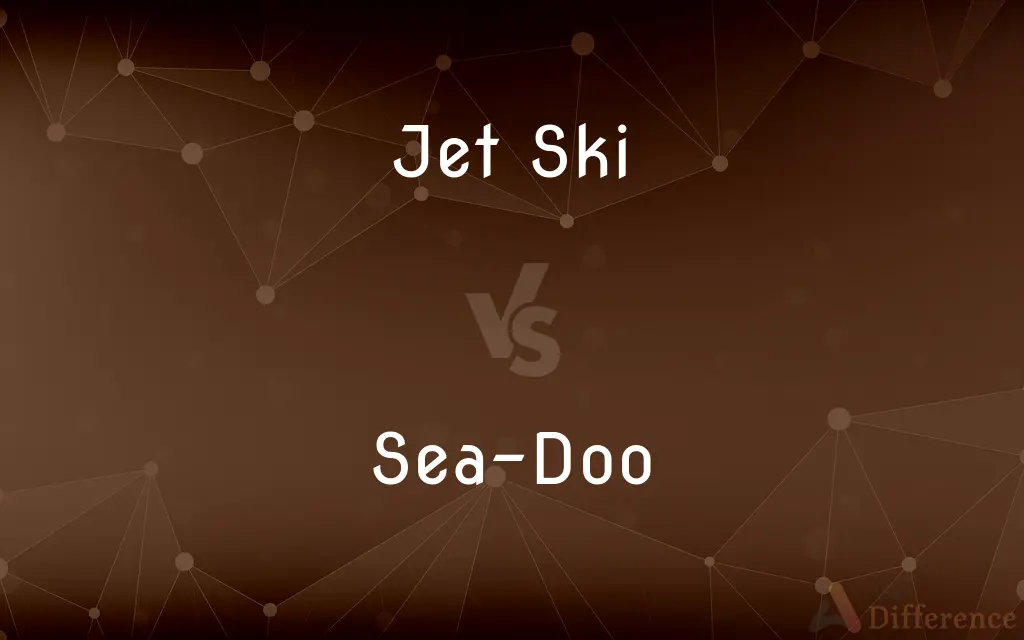Jet Ski vs. Sea-Doo — What's the Difference?
Edited by Tayyaba Rehman — By Fiza Rafique — Published on April 9, 2024
Jet Ski is a brand name for personal watercraft manufactured by Kawasaki, characterized by standing or sitting rider positions. Sea-Doo, a brand by Bombardier Recreational Products, offers sit-down models that emphasize comfort, family-friendly features.

Difference Between Jet Ski and Sea-Doo
Table of Contents
ADVERTISEMENT
Key Differences
Jet Ski and Sea-Doo are two leading brands in the personal watercraft (PWC) market, each with distinct characteristics and offerings. Jet Ski, a term often used generically to refer to any PWC, is actually a trademarked brand name owned by Kawasaki. The original Jet Skis were stand-up models designed for single riders, focusing on agility and speed. Over time, Kawasaki expanded its lineup to include sit-down models as well, catering to a broader audience looking for leisure and racing capabilities.
Sea-Doo, on the other hand, is a brand owned by Bombardier Recreational Products (BRP) and is known for its sit-down PWCs. Sea-Doo has been innovative in the PWC market, introducing features such as on-water brake systems, suspension, and models designed for specific activities like fishing. Sea-Doo's range includes models that prioritize comfort, stability, and family-friendly features, making them appealing for a wide range of uses from leisurely rides to towing sports.
Jet Skis are celebrated for their performance and versatility in both standing and sitting configurations, appealing to enthusiasts and racers, while Sea-Doos are lauded for their innovative design and comfort, catering to families and recreational users. Both brands offer various models to suit different needs, including entry-level, performance, and luxury categories, with advanced features and technology.
The choice between Jet Ski and Sea-Doo often comes down to personal preference, intended use, and brand loyalty. Kawasaki's Jet Ski models are ideal for those looking for high performance and the thrill of stand-up riding, while BRP's Sea-Doo models are suited for riders prioritizing innovation, comfort, and a variety of leisure activities on the water.
Comparison Chart
Brand Origin
Kawasaki Heavy Industries
Bombardier Recreational Products
ADVERTISEMENT
Launch Year
Introduced in 1973
Introduced in 1968
Key Models
Stand-up and sit-down models
Primarily sit-down models
Innovation
First to market, performance-focused
BRP's iBR brake system, suspension
Rider Position
Standing and sitting options available
Primarily sitting, focused on comfort
Target Audience
Performance enthusiasts, racers
Families, recreational users
Unique Features
Agility, speed, versatility
On-water brake, suspension, activity-specific models
Price Range
Entry-level to high-end
Entry-level to luxury
Usage
Racing, leisure, tow sports
Leisure, tow sports, fishing
Market Position
Known for performance and innovation
Known for comfort, innovation, and family-friendly features
Compare with Definitions
Jet Ski
Trademarked term often used generically for PWCs.
Many refer to all personal watercraft as Jet Skis, though it's a Kawasaki brand.
Sea-Doo
A PWC brand recognized for innovation and variety.
The Sea-Doo GTX Limited offers luxury features for comfort and performance.
Jet Ski
Offers models from stand-up to high-performance seated PWCs.
Kawasaki revolutionized water sports with its stand-up Jet Ski.
Sea-Doo
Offers specialized models for different water activities.
The Sea-Doo Wake Pro is designed specifically for wake sports.
Jet Ski
A brand of personal watercraft known for speed and agility.
The Kawasaki Jet Ski Ultra 310X is favored for its powerful engine.
Sea-Doo
Appeals to a wide audience with its diverse lineup.
From racing to leisurely cruising, Sea-Doo has a PWC for every type of rider.
Jet Ski
Known for durable and reliable watercraft.
Jet Ski owners often praise their PWCs for long-lasting performance.
Sea-Doo
Introduced the first onboard brake system in PWCs.
Sea-Doo's iBR system allows for safer and more controlled stops.
Jet Ski
Emphasizes performance and power in its designs.
Kawasaki's Jet Skis are a popular choice for competitive watercraft racing.
Sea-Doo
Focuses on fuel efficiency and eco-friendly technology.
Sea-Doo's ECO mode helps reduce fuel consumption and emissions.
Common Curiosities
Can Jet Ski models only be used for racing?
No, Kawasaki offers a range of Jet Ski models suitable for various activities, including recreational riding and competitive racing.
Can I tow with a Sea-Doo or Jet Ski?
Yes, both brands offer models capable of towing, though specific models like the Sea-Doo Wake are specially designed for towing sports.
Are Jet Skis more expensive than Sea-Doos?
Pricing varies based on model and features. Both brands offer models across a wide price range, catering to different budgets.
Are there any eco-friendly options available for Jet Skis or Sea-Doos?
Sea-Doo offers models with eco-friendly features like the ECO mode for better fuel efficiency. Kawasaki also focuses on efficient engine designs to minimize environmental impact.
Which is better for beginners, Jet Ski or Sea-Doo?
Both brands offer models suitable for beginners. The choice depends on personal preference, desired features, and budget. Sea-Doo's models with the iBR system may offer additional confidence for new riders with enhanced safety features.
Does Sea-Doo offer any stand-up models like the Jet Ski?
Historically, Sea-Doo has focused on sit-down models, though the market trends and consumer preferences can influence future offerings.
How do I decide between a Jet Ski and a Sea-Doo for family use?
Consider the seating capacity, stability, and ease of use. Sea-Doo's lineup includes models designed for family fun with features like a large swim platform and tow hook for water sports.
Can Jet Skis and Sea-Doos be used in both fresh and saltwater?
Yes, they can operate in both fresh and saltwater. However, saltwater use requires thorough rinsing and more diligent maintenance to prevent corrosion.
What is the warranty coverage for Jet Skis and Sea-Doos?
Warranty coverage varies by model and region. Typically, both brands offer a limited warranty that covers parts and labor for certain components for a specified period.
Can I customize my Jet Ski or Sea-Doo?
Yes, both brands offer a range of accessories and customization options to enhance performance, comfort, and style.
What safety equipment do I need on a Jet Ski or Sea-Doo?
Required safety equipment includes life jackets for all riders, a safety lanyard (cut-off switch), and, depending on local laws, a fire extinguisher, whistle, or other sound-producing device.
How does the speed of Jet Skis compare to Sea-Doos?
Both brands offer high-speed models. Kawasaki's Jet Ski Ultra 310 series is known for its speed, while Sea-Doo's RXP-X 300 is a top contender in speed and acceleration.
What maintenance do Jet Skis and Sea-Doos require?
Both require regular maintenance, including engine checks, oil changes, and hull inspections. Always rinse your PWC with fresh water after use in saltwater.
What are the top models from Jet Ski and Sea-Doo for racing?
For Kawasaki, the Jet Ski Ultra 310R is a top choice for racing due to its powerful engine and sporty handling. Sea-Doo's RXP-X 300 is renowned for its performance and agility in races.
Is it easy to find parts and service for Jet Skis and Sea-Doos?
Yes, both Kawasaki and BRP have extensive dealer networks worldwide, making it relatively easy to find parts and service for Jet Skis and Sea-Doos.
Share Your Discovery

Previous Comparison
Classic Fit vs. Regular Fit
Next Comparison
Assignment vs. SubleaseAuthor Spotlight
Written by
Fiza RafiqueFiza Rafique is a skilled content writer at AskDifference.com, where she meticulously refines and enhances written pieces. Drawing from her vast editorial expertise, Fiza ensures clarity, accuracy, and precision in every article. Passionate about language, she continually seeks to elevate the quality of content for readers worldwide.
Edited by
Tayyaba RehmanTayyaba Rehman is a distinguished writer, currently serving as a primary contributor to askdifference.com. As a researcher in semantics and etymology, Tayyaba's passion for the complexity of languages and their distinctions has found a perfect home on the platform. Tayyaba delves into the intricacies of language, distinguishing between commonly confused words and phrases, thereby providing clarity for readers worldwide.
















































